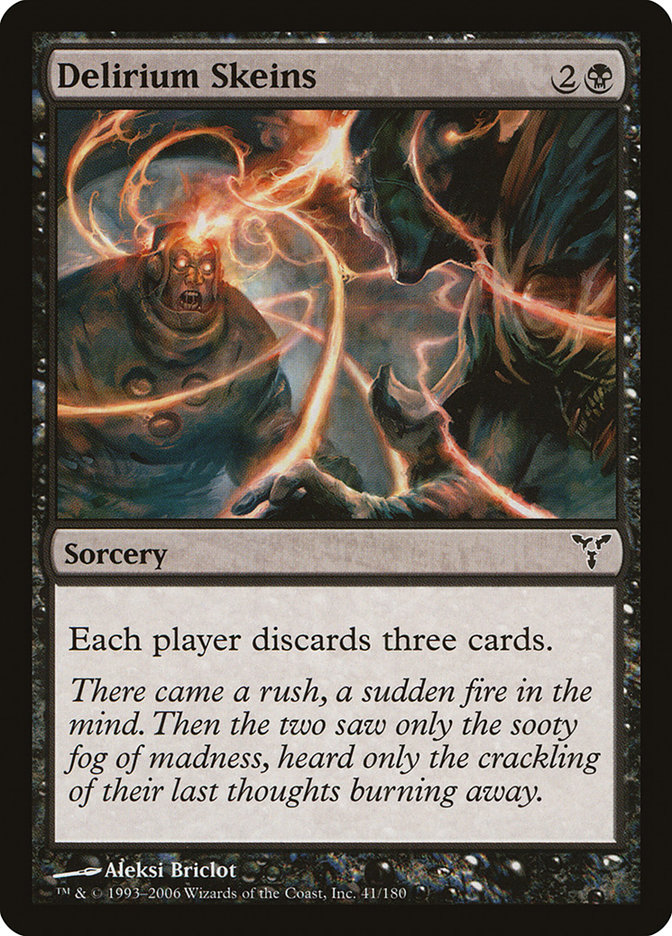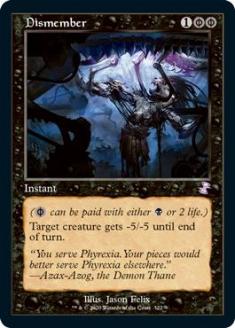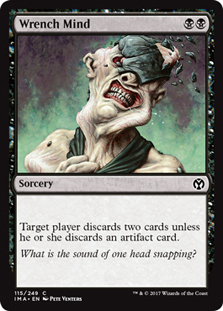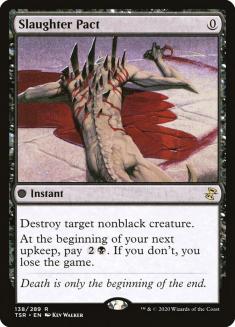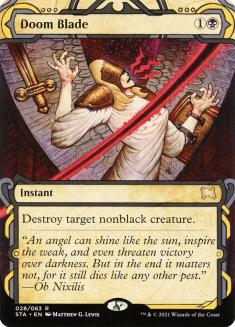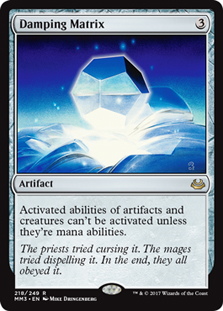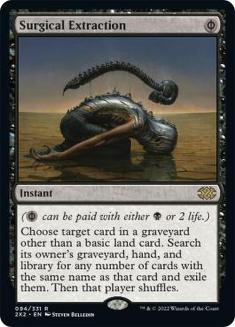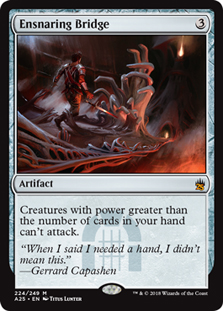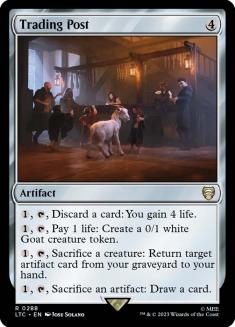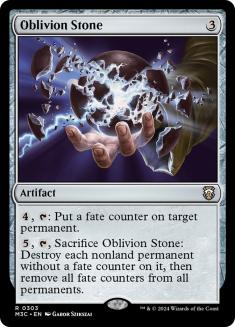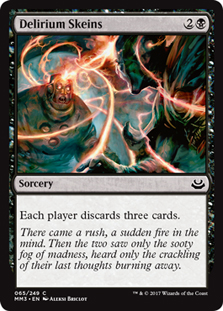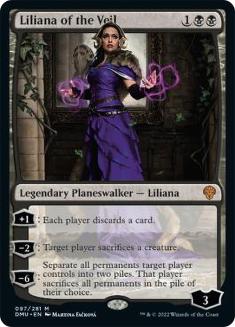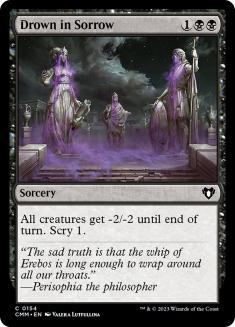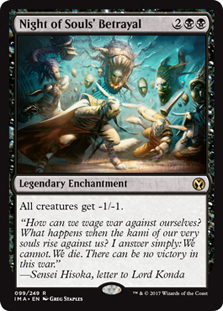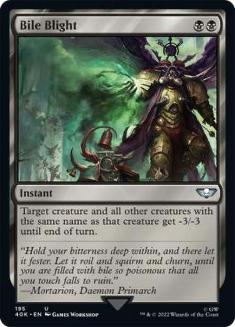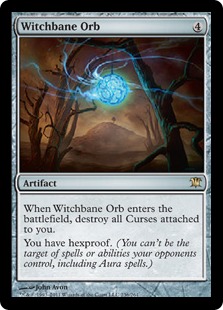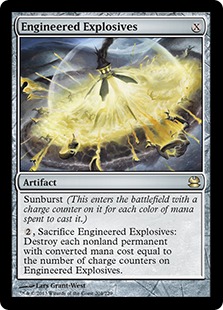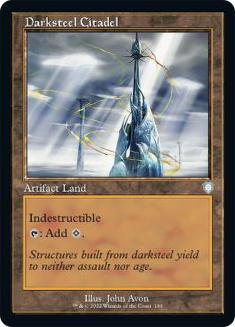
Today’s deck, like many before it, began with a spark from a friend.
Back at the beginning of the summer, one of my D&D buddies took a job at a local shop. Because of the frequency of Modern events at his new place of
employment, he asked me for some assistance building a fun but budget-friendly Modern deck that revolved around one of his favorite cards in his early
years: Megrim. He wanted to have a deck on hand, but he didn’t want to break the bank trying to sleeve up something fun.
Instead of starting from scratch though, my pal gave me a preliminary list with Grixis colors and a fairly complicated spell list. Although it was
wallet-friendly I was concerned that, with mana-fixing built on Guildgates alone, it may not be fun-friendly. I pored through the last ten years of Magic
and slashed two colors from the list. I rooted out some cards I hadn’t thought about since they were Standard legal and, after a bit of pricing, I came up
with a deck that, sideboard and all, would come up just short of $70.00 to buy and sleeve.
Creatures (14)
Lands (24)
Spells (22)
- 2 Duress
- 4 The Rack
- 3 Blackmail
- 2 Mindstab
- 3 Smallpox
- 2 Raven's Crime
- 3 Liliana's Caress
- 3 Underworld Connections
Sideboard

I passed the list on, content to transfer the fun brew into his capable hands. But then I looked at the file again, and it looked pretty fun. The cost
wasn’t at all prohibitive–it’d be a shame if I didn’t playtest it first. I mean there’s a lot of neat cards – whoa, how’d my decklist end up in my cart?
Oops, and I accidentally clicked “buy!” Darn it, I even gave them the correct shipping information! Well, I guess I can’t waste the opportunity.
I assembled the deck, adding in my non-budget playset of Liliana of the Veil and played it out several times. It was reasonably fun, but it felt decidedly
weak. Cards like Blood Scrivener and Blackmail never worked like you would hope, and Underworld Connections was too clunky to use effectively.
Decks like this already exist in Modern, usually under the moniker “Eight-Rack,” to indicate a playset each of The Rack and Shrieking Affliction. I decided
to move all-in on this plan. Our area had a PTQ on August 23rd, and I was still without a solid deck plan; maybe this could do it. More cards magically
appeared in my mailbox, and I sleeved up version two.
Planeswalkers (3)
Lands (22)
Spells (35)
- 4 The Rack
- 1 Wrench Mind
- 1 Darkblast
- 3 Delirium Skeins
- 3 Mindstab
- 3 Smallpox
- 3 Thoughtseize
- 1 Raven's Crime
- 2 Nihil Spellbomb
- 3 Dismember
- 3 Geth's Verdict
- 4 Shrieking Affliction
- 4 Waste Not
Sideboard

I launched into testing this one much more extensively, carrying it with me to my shop for even non-related events in the hopes that someone else also
needed to test some Modern. I was pleased with the way this deck played, but not necessarily with the card choices and sequencing. Although this list
packed a lot more discard, it still wasn’t perfect. Pack Rat, a novel addition in the sideboard, came in frequently until I finally just left it there.
Shrieking Affliction, on the other hand, didn’t deal damage as reliably as The Rack, so I backed down on those a little bit.
By this time, we were smack in the middle of the July heat, and the PTQ the following month was getting closer and testing opportunities would become more
frequent. I cut and shifted ruthlessly until every card was unshakeable, picking up singles locally here and there until I was perfectly satisfied. Testing
proved positive, and I did especially well against some of the best mainstream decks in Modern.
Before I knew it, the PTQ was upon me. All the twisting and turning had given me a list I was finally content with. Given the reduction of two Rack-like
effects and the addition of everyone’s favorite Standard Rat, I decided to flex my mental muscles and name this deck appropriately.
Now that we have the final list, let’s dive in!
Creatures
Four Pack Rats and four Mutavaults; yes, these eight cards are shared with the vast majority of the current Standard behemoth, and these are only the first
of several. However, Pack Rat provides reliability and consistency in a format where tutoring, perfect mana, and zero-cost spells are the norm. The ability
to forcibly discard and shrink my hand size is often relevant too. Originally, I considered running them alongside Rotting Rats from an earlier list to
provide an extra pump.
Noncreature Permanents
The Rack is the star of the show. A card only made legal by a serendipitous reprint as a Timeshifted card in Time Spiral, The Rack has been a casual
favorite since its first printing in the mid-nineties. Conversely, its companion is Shrieking Affliction, a Standard-Legal complement to the traditional
one-drop artifact. They perform similar but different roles. The Rack deals damage which means that it can interact with planeswalkers. On the other hand,
things that prevent damage can stop The Rack from hurting your opponent. The Rack covers a wider range of hand sizes; if your opponent stays on two cards,
they’re still taking damage. Shrieking Affliction is more powerful (dealing full damage at one or zero cards) and is thus more powerful if you can keep
them to one card in hand or less. It also involves life loss, so there’s no way to prevent or redirect it, for better or worse. Thankfully, neither targets
a player, so hexproofing oneself with cards like Leyline of Sanctity does not stop these.
Liliana of the Veil is just awesome. I waffled on the number to include in the maindeck, but she’s been a playset for a while now. As is the case with
drawing multiples in the Modern Black deck, they’re great discard fodder for Pack Rat or to another Liliana of the Veil as long as her position is
protected. Liliana and The Rack can effectively lock your opponent out of the game if they do not draw an answer to either. Most of the time you will be in
a position to start discarding, but sacrificing is frequently relevant.
Nihil Spellbomb is an unusual mainboard card, but it gives me a nice, non-disruptive way to deal with a graveyard on-demand as well as a way to “store” a
card when I need to draw it after activating Liliana’s +1 ability. Only in the fastest matchups will it prove to be bad, and even then, it still draws a
card when there’s a pause in the battle.
Ensnaring Bridge and Trading Post round out the list. Ensnaring Bridge is an excellent defensive artifact to play against anything that wins in combat,
from Zoo to Twin to Pod. It’s worth noting that it does stop me from attacking, but more on that later. Trading Post is, admittedly, one of my
favorite cards in the history of Magic. The flavor and potential of this card is through the roof, and by golly if I get a deck that wants it, I’ll take it
no matter what format I’m in. When I’ve depleted all my resources, Trading Post provides a constant source of action, whether it’s gaining four life,
smashing an Ensnaring Bridge so I can attack with an army of Rats for the kill, or creating a Goat to block a massive Tarmogoyf, the Post never fails me if
I untap with it. Well, at least I don’t remember if it fails me.
Spells
Without a doubt, Delirium Skeins is the strongest spell in this deck. Forcing your opponent to discard three cards for three mana is immensely powerful;
you’d be surprised how many decks have three cards in hand on turn 3. Moreover, my whole hand is dedicated to getting them out of cards, so it’s often the
most efficient way to “spend” my hand. Lay out two or three The Rack effects and let ‘er rip! More than any other spell, you can see the despair on their
face as they mutter, “Okay, it resolves,” and place a neat stack of cards in the graveyard. You wouldn’t think that a small upgrade from Mind Rot makes a
big difference, but it really, really does. It’s also a great topdeck if they’re starting to climb out of Rack range.
Thoughtseize and Inquisition of Kozilek fulfill similar, redundant roles, but the ability to interact turn 1 is essential for a deck like this to function.
It gives you valuable information too, even if you don’t have any targets of relevance. Choosing the right card on turn 1 can often mean the difference
between a win and a loss. Thoughtseize is powerful in every format, and Modern is perhaps where it shines brightest, allowing you to remove combo pieces
and crippling turn 1 plays.
Dismember is still one of the best removal spells ever printed, and I truly think it’s best in a black deck. It’s difficult to sign up for a Boros Charm to
the face every time you cast it, so in a mono-black deck, Dismember is much more flexible. It’s a great combo breaker, and being able to cast it off one of
the deck’s many colorless lands is a huge bonus. The other removal, Doom Blade and Slaughter Pact, provide efficient spot removal. Slaughter Pact is
especially good; I can cast it at the same time I cast Delirium Skeins or Liliana and still be able to kill something and use my hand efficiently. It
provides a very firm sense of security, letting you comfortably tap out.
Raven’s Crime came in and out several times over deckbuilding, but the ability to pummel my opponent’s hand every turn I draw an extra land seemed
powerful; it’s a fifth Liliana of the Veil that’s difficult to interact with. It also provides an additional option for an extra land (if I don’t want four
life from Trading Post or a Rat token). Similarly, Wrench Mind only recently returned to the list. The efficiency of two cards for two mana ended up being
too good to pass up.
In the land department, fourteen Swamps were necessary in a world of Blood Moons and in a deck needing lots of untapped black sources. An entire playset of
Mutavaults is also a critical addition with Pack Rat. Still, Mutavaults are great at smashing face by themselves when the field is empty. Urborg, Tomb of
Yawgmoth makes my mana smoother and gives me more flexibility in what mana I tap. Ghost Quarter is my Wasteland of choice. Although most Modern decks play
Tectonic Edge, I specifically chose Ghost Quarter despite extensive testing with the Edge. Ghost Quarter requires no additional mana to activate, and it
still performs the same purpose: neutralizing a problematic non-basic land. For my part, the card disadvantage is often perfectly acceptable if it deals
with a hard-to-target non-basic land. Darksteel Citadel, a lonely singleton, is also a fun target for Ghost Quarter. If I’m fighting a deck rife with basic
lands, I can smash my Quarter against the Citadel and convert it instantly to a Swamp, all without the life loss of a Marsh Flats! The Citadel is also a
sacrifice and/or recover target for Trading Post, and the presence of so much black mana means that an occasional colorless dud is fine.
On the Saturday of the event, I got a couple mind-focusing donuts from my favorite local bakery and tootled up the road to the PTQ on the east side of
Louisville. I hustled inside where dozens of players had already started gathering for a noon start time. Among them was my first opponent of the day, Ben.
Ben, a Bloomington, Indiana native, had driven a couple hours on back roads to make the event, and he was excited to play his Island-laden list. Before the
tournament began, we decided to test against each other and make some conversation.
Round 0 – Ben (Fish)
After several games, I cracked the Fish puzzle and defeated Ben 4-1. My removal and draws proved timely enough to manage the flow of folk. He was
comfortable with the list and resigned that the corner Rack deck would be a bad matchup.
“1”-0
Shortly after we wrapped up, though, it was go time. I was actually quite nervous; despite the tournament’s roughly small size of 137 players, I knew
everyone was a tournament-ready brawler, and every round would be a serious test of skill and concentration.
Round 1 – Aeron (R/G Tron)
Aeron, who had traveled a short distance to compete (Cincinnati, if my memory serves), was on a familiar Tron plan. Although I did my best to shrink his
hand before I got buried in colorless monstrosities, he assembled Tron almost naturally and Karn Liberated picked apart my Liliana and my hand. A flimsy
Dismember on a Wurmcoil Engine (still a 6/6, as I lacked combatants) was my death throe, and we went to game 2.
Out:
In:
Game two saw an on-time Damping Matrix for me. Damping Matrix is perfect for stopping the deck’s Expedition Maps and Oblivion Stones. Thankfully, I kept
him off Tron long enough that Liliana took over the game, destroying his Oblivion Stone the turn after he played it with her -6, and The Rack and friends
finished the job. Game 3 went similarly, though it included a play where I Ghost Quartered his Urza’s Mine and cast Surgical Extraction to eradicate the
land from the game. Without enough mana to produce anything, game 3 finished in much the same way as game 2.
1-0
Ghost Quarter was an exceptional card in this matchup. If I had seen one in game 1, I might have clinched that one too. Damping Matrix proved to be a
necessary non-bo; it turns off a lot of my spells, too, but sometimes it’s what you need to play.
Round 2 – Riley (Junk Pod)
Riley had traveled with several friends to the event, as I saw him chatting with neighbors who knew him by name. Riley was an aggressive player but a
friendly opponent nonetheless. I put him on Pod almost immediately after seeing Voice of Resurgence coming down. My mull to six with one colorless land
proved to be mortally slow, and Kitchen Finks and friends smashed me to rubble in a few short turns. I did see the Birthing Pod though, so I decided on a
safe sideboard.
Out:
In:
Discard was not going to be how I won this game, and even Trading Post was too slow to be effective. I needed all the removal and activation disruption as
I could fit, and I sided a Witchbane Orb in case he was on the Murderous Redcap infinite combo plan in game 2.
Another mull to six one-lander met me, and a couple insignificant removal spells put me in the same place I was first game, drawing a worthless Liliana of
the Veil against a Kitchen Finks. I cursed under my breath as I looked back at my deck’s most expensive card, and I scooped hurriedly.
1-1
Riley went on to explain that one of his friends, who also plays a black Rack-based deck described Riley’s Pod deck as “a nightmare matchup.” Although I
would agree it was difficult, I believe it would have been winnable with a more favorable draw. I started each game fairly far behind and kept hands I
shouldn’t have. All I could hope for at this point was no more Pod decks.
One loss was still top 8-able, but two spelled certain death. I resolved to play until I lost another match. If I lost another match.
#positivethinking
Round 3 – Travis (Burn)
Travis sat across from me in the player meeting, so we were already familiar with each other as we’d chatted for a few minutes while we waited for live
pairings to go up. I had no idea what he was on, but it quickly became apparent with Mountain, suspend Rift Bolt. Now my plan was to do as little damage to
myself as possible. A timely Delirium Skeins put me at a low four points of life, but it left both of us with no hands. My one Rack started to do some
work, and he flooded out.
Out:
In:
In game 2, I got a couple early discard spells on him, happily trading two life from a Thoughtseize for a Boros Charm. Eidolon of the Great Revel met
Liliana’s sacrifice effect, but my topdecked The Rack and Trading Posts each met with a Wear // Tear and a Smash to Smithereens, respectively. In one turn,
I knew he had Skullcrack and another card in his hand. I played Liliana up to force a discard, then played a second Liliana for each of us to
discard. I had Trading Post and mana up to discard, but he responded with a Skullcrack. I responded by discarding my card to the Post and going from seven
down to four. He got Racked out before long. If he’d passed priority back, we would have both discarded, and I would have been at three and dead to almost
any topdeck of his. Thankfully, he didn’t draw any more burn and I clinched the round.
2-1
Round 4 – Bobby (Esper Gifts)
Bobby, one of the more venerated players in the area, was extremely local, i.e. he worked at the hosting shop. In game 1, he got a stubborn land draw and a
Liliana. Although he plucked one Liliana from my hand, I drew another and jammed it. My Mutavault smashed away at his Liliana while he continued to draw
lands until The Rack sealed the game.
Out:
In:
In game 2, he got a Lingering Souls online quickly, but I starting holding up the game with Ensnaring Bridge. A Surgical Extraction plucked an Unburial
Rites from his graveyard, revealing it was the only copy. His deck was full of Cryptic Commands, which could bounce my Ensnaring Bridge at any time. I
tried to assemble the best defense I could, but he started stockpiling Spirits and cards in hand, waiting for the big moment. Without any pressure, he
stuck the Command, the Bridge bounced, and I was toast.
Game 3 proceeded like the first one with strong Nihil Spellbomb showings and enough Rack pressure to finish the job.
3-1
Beating Bobby gave me a great confidence boost; having never beaten him in the Standard events in which we’d battled, I felt accomplished. Bobby is always
an excellent sport too.
Round 5 – Joe (Scapeshift)
Joe was a nice fellow, excited to do battle. A first turn Search for Tomorrow revealed his plan, but truth be told, I can’t do too much against it. An
early Inquisition of Kozilek revealed a three-of-a-kind Remand, and I knew I’d have to play around as many of them as I could. I baited him with one-drop
spells until he eventually bit, and I drew them all out. However, even with The Rack and Liliana of the Veil online, he still drew the stone Scapeshift,
and I scooped after what would have been the exactly lethal eighteen damage. Darn Thoughtseize.
Out:
In:
Postboard, my plan is to Extract a discarded Scapeshift or to stick a Witchbane Orb, protecting from Valakut’s heat. Trading Post, similarly, lets me gain
sufficient life to put me out of insta-dead range, given enough time. In game 2, an early flurry of discard put three Scapeshifts in the yard. I scratched
my head and, with a Snapcaster Mage on my mind, I didn’t crack my Nihil Spellbomb early. I defeated him handily the second game. In the third game, my
Thoughtseize revealed Obstinate Baloth, an enormous problem considering I’d cut everything but a Slaughter Pact to deal with it. He eventually hard cast it
alongside a couple Sakura Tribe-Elders. He was very smart though: he didn’t sack his Elders so they could act as a buffer against Liliana of the Veil. He
did the math and put me to fifteen life with a Baloth and a single elder left. I couldn’t draw one of my few outs, and I was smashed to bits a couple turns
later.
3-2
Joe, ever an honorable opponent expressed thanks and a well-played game. Joe, like many others at the event, was very kind, gracious, and sportsmanlike.
Win or lose, it feels good to compete in a community that’s just happy for you to be there.
In retrospect, I feel like the deck performed extremely well, though it needs some help to shore up the bad matches. Control decks and midrange are putty
in my hand, and even some combo strategies can be broken up by discard, but Joe’s Scapeshift deck proves that there are some matchups that are almost
non-interactive for me save a lucky Thoughtseize/Surgical Extraction draw. Similarly, hyper-aggressive, toolbox decks like Pod were very challenging. I was
scared of Scapeshift, Tron, and Burn, but Pod easily rose to the top of the list. The creatures in it are too high-value for me to effectively remove.
I will continue to improve this deck, and one day I might take it to a Premier Modern event on an Open Series Sunday. It’s a blast to play, and it puts you
in the driver seat in a way Blue can only dream of.
The Rack and friends constitute a familiar casual strategy; do you know someone that always turns to this kind of list for a casual event, or are you that
person? Where do you go when you travel down the discard path?


